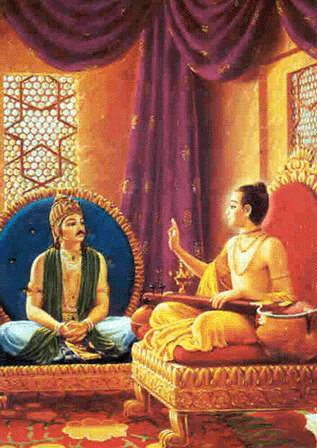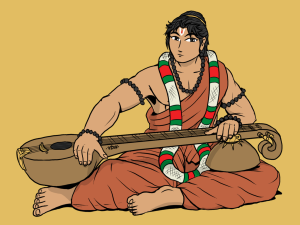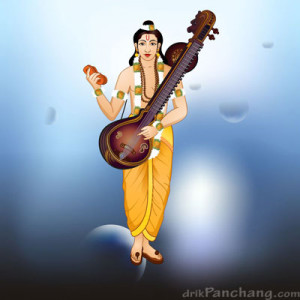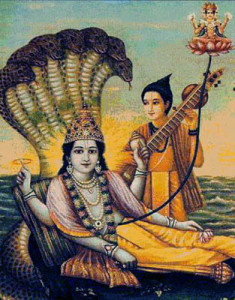The Story Begins
Long ago, there lived a king named Prachinabarhi. He desired to attain pure wisdom and free himself from the bonds of Karma. Seeking this knowledge, he approached the sage Narada, who began reciting the following story:
Puranjana and Avigyathan
Once, there were two friends named Puranjana and Avigyathan. Both were of the same age, brilliant, free, happy, and always together. While wandering, Puranjana came across a magnificent palace with nine gates at the foothills of the Himalayas, called Nawadwarapuri. Enchanted by the palace, he forgot about his friend Avigyathan and fell in love with it.
As Puranjana approached the palace, a beautiful lady named Puranjani emerged from the fort, accompanied by a five-headed snake as an umbrella, eleven bodyguards, and many soldiers. Puranjana was captivated by her beauty and inquired about her. She introduced herself as the queen of the palace, searching for a suitable groom. Puranjana and Puranjani decided to marry and lived together happily in Nawadwarapuri. Puranjana followed everything Puranjani said, and they enjoyed their life together.
The Arrival of Durbagai
There was a female named Durbagai, the daughter of Kaalan. She was disliked by everyone and was searching for a husband. One day, she approached Narada Muni and asked him to marry her. Narada refused, and in her anger, she cursed him to wander throughout his life, never staying in one place. Narada suggested she marry a person named ChandaVegan. Durbagai then approached ChandaVegan, who agreed to keep her with him but did not marry her.
ChandaVegan had a brother named Prajvaran and a formidable soldier named Bayan. Together with Durbagai’s father, Kaalan, they decided to capture various palaces. Whenever they captured a fort, it became completely useless. One day, they attacked Nawadwarapuri. Durbagai stepped in first, killing the five-headed snake. Prajvaran burned the place, Bayan entered Puranjana’s private space, and Kaalan followed. Puranjana and Puranjani cried as their palace was destroyed, and Puranjana was killed. He died thinking about Puranjani.
Rebirth and Realization
As Puranjana died thinking of a lady, he was reborn as a woman, the daughter of the king of Vidarbha. She married a Pandiyan king named Malaiyathvajan. After some years, the king left his kingdom for the forest to do penance, and she followed him. In the forest, Malaiyathvajan performed tapas and eventually died. She prepared to immolate herself on his funeral pyre but was stopped by a scholarly Brahmin.
The Brahmin revealed that she was actually Puranjana, who had been separated from his friend Avigyathan. Dying while thinking of Puranjani led to his rebirth as a woman. The Brahmin explained that this cycle of birth and rebirth would continue unless she sought liberation. Upon remembering everything, she asked about Avigyathan. The Brahmin then revealed himself as Avigyathan and told Puranjana not to be carried away by any palace (body) and they both began to live together happily again.
The Essence of the Story
King Prachinabarhi, perplexed by the story, pleaded with Narada for its meaning. Narada explained:
- Puranjana: Represents the Jiva (soul).
- Avigyathan: Represents the Supreme Personality of Godhead, who is beyond comprehension.
- Nawadwarapuri: Represents the human body with its nine gates (orifices).
- Puranjani: Represents the Buddhi (intellect) that controls the body.
- Five-headed Snake: Represents the five vital airs (Prana, Apana, Vyana, Udana, and Samana).
- Eleven Bodyguards: Represent the eleven senses (five sensory organs, five organs of action, and the mind).
- Soldiers: Represent the multitude of thoughts in the mind.
- Durbagai: Represents old age.
- ChandaVegan: Represents the lifespan.
- Prajvaran: Represents fever.
- Bayan: Represents the fear of death.
- Kaalan: Represents death itself.
When Durbagai (old age) enters the body, it becomes weak and useless. Prajvaran (fever) and Bayan (fear of death) follow, and finally, Kaalan (death) arrives. The body deteriorates, and the soul (Jiva) becomes attached to the body and the intellect (Buddhi), leading to repeated cycles of birth and rebirth. Liberation from this cycle requires the guidance of a guru. When the guru (representing God) arrives, he helps the soul realize its true nature and attain liberation.
Lessons to be Learned
- Attachment Leads to Suffering: Attachment to the body and material possessions leads to repeated cycles of birth and death.
- Seek Higher Knowledge: True wisdom and liberation come from understanding the Supreme Personality of Godhead.
- The Role of a Guru: A guru is essential in guiding the soul towards liberation and understanding its true nature.
- The Importance of Detachment: Detachment from the material world and attachment to the Supreme leads to liberation.
Related Quotes
From Srimad Bhagavatam
- “One who has taken his birth as a human being should make his life successful and work for the ultimate liberation, avoiding a life of sense gratification and the path of repeated birth and death.” (SB 11.9.29)
From Caitanya Caritamrita
- “One who thinks himself lower than the grass, who is more tolerant than a tree, and who does not expect personal honor but is always prepared to give all respect to others can very easily always chant the holy name of the Lord.” (Adi 17.31)
From Srila Prabhupada’s Writings
- “Human life is meant for plain living and high thinking. Since all conditioned souls are under the influence of the material nature, they engage in sense gratification.” (Bhagavad-gita As It Is, Introduction)
Prayer
Prayer for Liberation and True Knowledge
“O Supreme Personality of Godhead, grant me the wisdom to see beyond the material world. Help me to detach from the temporary pleasures of life and seek eternal knowledge. Guide me towards a true guru who can illuminate my path to liberation. May I always remember Your divine presence and live a life of devotion, free from the cycle of birth and death. Om Namo Bhagavate Vasudevaya!”
Note
For a detailed narration, please refer to Srimad Bhagavatam Canto 4, Chapters 25 to 29.
4o



